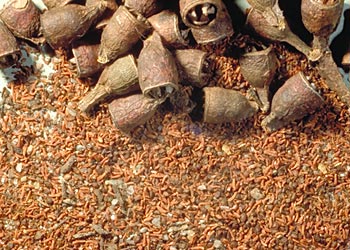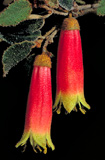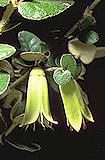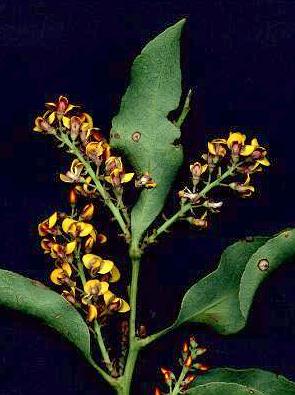|
[Front Page] [Features] [Departments] [Society Home] [Subscribe]

Short Cuts
Short items of interest about Australian plants selected from the many newsletters and journals published by member Societies of ASGAP.......
Short Cuts in this issue:
 Eucalypt Seeds Eucalypt Seeds- From little things big things grow....
 Propagation of Prostrate Acacias Propagation of Prostrate Acacias- Prostrate wattles need to be propagated vegetatively to maintain the prostrate habit
 Paws to Burn! Paws to Burn!- Setting fire to your kangaroo paws! Yes...really!
 A Hitchhiker's Guide to Correa reflexa A Hitchhiker's Guide to Correa reflexa- A look at the Correa that you are most likely to encounter in the wild - and in cultivation
 Some Low Maintenance Thoughts Some Low Maintenance Thoughts- Some simple techniques to reduce the drudgery and increase enjoyment
 The Hop Bitter Pea - Daviesia latifolia The Hop Bitter Pea - Daviesia latifolia- A common but unrecognised member of the "pea" family

Eucalypt Seeds
Think about a eucalypt seed for a moment. Bored?? Well, Tony Bean thinks you shouldn't be! They are small admittedly, but quite remarkable.
Is it not awesome to contemplate that a seed weighing just a hundredth of a gram can eventually grow into a 100 metre high forest giant? Internally, a seed consists of a small, living, though quiescent plant-genetically the product of the current generation and potentially an individual of a new generation.
But if these thoughts do not impress you, the physical diversity of eucalypt seeds surely will. Close examination of eucalypt seeds reveals a wonderful new world.
The seeds of any one species are more or less constant, but different species vary greatly; in size, colour, shape, and surface features. A microscope is the ideal way to examine seeds at close quarters, but a 10x hand lens is sufficient to unlock many of the marvellous mysteries.
The largest eucalypt seeds are those of Corymbia calophylla (Marri). They are about 15 mm long, black and glossy, and weigh about one-seventh of a gram. Almost as large are the seeds of C.haematoxylon and C.ficifolia.
The smallest seeds are those of Eucalyptus howittiana, E.brachyandra, E.thozetiana and a few other species. They are only about half a millimetre long and broad, and weigh less than one thousandth of a gram!
Eucalypt seeds vary greatly in colour, and may be black, brown, yellow, orange, or even red. They are all shapes, from the linear seeds of E.curtisii to the chunky cuboid seeds of the stringybarks.
Perhaps the most amazing and unexpected feature of eucalypt seeds are their variety of surface features. Some seeds are almost perfectly round and smooth. Seeds of E.redunca (and related species), if placed on a piece of paper, literally roll around like tiny marbles! Other seeds look like miniature pieces of honeycomb-deeply pitted and with toothed edges. Examples are E.torquata (Coral Gum), E.salubris (Gimlet) and E.brachycalyx (Gilja). Still others are quite jagged or angular eg. E.tetraptera.
Some are boat-shaped, and even have a distinct "keel" eg. C.peltata. Some seeds are winged, and many have shallow reticulations.
The great diversity shown by the various species' seeds means that they are of some importance in the classification of species into their correct groups. Often examination of seeds can determine which Section or Series it belongs to. Sometimes seeds are so distinctive that the actual species may be identified eg. C.calophylla, E.curtisii, E.microcorys, E.deglupta.
| |  |
| | Seeds (and chaff) of the river red gum
(Eucalyptus camaldulensis) |
Seeds of Angophora species and paper-fruited bloodwoods (Blakella) are saucer-shaped, sometimes with a rudimentary wing surrounding it. Bloodwood seeds are large - some are winged and some are not. This is at times a useful diagnostic feature. For example, C.calophylla and C.ficifolia can be easily separated by looking at their seeds. C.calophylla seeds are black and wingless; C.ficifolia seeds are brown and prominently winged. The eastern Monocalypts (stringybarks, ashes, peppermints) are the least varied of all eucalypts, but are still worth looking at.
An interesting exercise, which everyone would be able to do, is to collect a few gum nuts from a few different eucalypt species, wait for them to expel, and then examine the seeds under a hand lens. You'd be surprised how fascinating this can be. But beware - not everything that comes out of a gum nut is a seed. There is also chaff! The intricacies of chaff could comprise another complete article, but suffice to say here that the viable seeds are generally larger and darker than the chaff, and also are located at the bottom of the fruit (gum nut).
If you would like to learn more about gum-tree seeds, the definitive reference on the topic is Eucalyptus Seed by Boland, Brooker, and Turnbull. Published in 1980, by C.S.I.R.O.
From from the Eucalyptus Study Group Newsletter No. 8 March, 1985.
[ Return to Index
]

Propagation of Prostrate Acacias
A number of prostrate forms of normally upright growing acacias have become available in recent years. Paul Carmen offers a few tips on overcoming propagation problems
Spring visitors to the Australian National Botanic Gardens (ANBG) often remark on the many prostrate acacias cascading over walls or mounds or forming extensive groundcovers. Species include Acacia baileyana prostrate form, A.cardiophylla 'Gold Lace', A.cultriformis 'Austraflora Cascade', A.dealbata 'Kambah Karpet', and A.pravisissima 'Kuranga Cascade'.
Unfortunately these desirable species must be propagated vegetatively to maintain their prostrate character but they are often difficult to grow from cuttings. The main problem encountered is leaf drop on the cuttings. ANBG has found that cuttings of these acacias need to retain their leaves for at least three to four weeks for roots to develop.
A check of ANBG records on the computer system ' IBIS ' (Integrated Botanical Information System) showed that a range of rooting hormones and other treatments have been tried. The results, although not conclusive, suggest the following:
- A rooting hormone concentration of between 3g/l - 6g/l IBA with 50% ethanol carrier and 5 second dip is most effective.
- The best time of year for taking cuttings in Canberra is autumn/winter (April-August).
- Regular pruning of the stock plant to encourage new growth may increase strike rate.
Good luck with your attempts!
From the June 2001 issue of the Journal of SGAP's Canberra Region.
[ Return to Index
]

Paws to Burn!
If your kangaroo paws show lack of vigour or fungal diseaase - set them on fire!!
Jeanette Closs reports....
Some time ago I read in the Australian Plants journal a report regarding the cultivation of Anigozanthos species. On checking the December 1988 issue I found that Brian Walters of New South Wales Region had written an article mentioning the 'inkspot' and 'rust' diseases that attack some of these plants. As most growers will know, inkspot can be a very debilitating problem as it appears to result in the breakdown of the cell structure of the leaves. It is characterised by black spots on the leaves, which gradually increase in size.
Brian writes:
"There is no real cure for either disease. However, certain cultural methods may assist in control. Plants should, for example, be grown in sunny, open positions where there is good air circulation. Overhead watering should be minimized. A suggestion made to me recently seems to have merit (and should at least appeal to any pyromaniacs out there!) This involves setting fire to the foliage after flowering to destroy the diseased leaves and fungal spores and to stimulate new growth from the rhizome."
In the past couple of years I have followed this advice. In March I cut back the flower stems and foliage to about 30 cm from the ground. Much of this foliage I pile onto the reduced plant and leave for a week or two to dry out. I then light a fire with the help of a 'firelighter' (or some newspaper). Depending how dry the material is, this can burn quite fiercely, so nearby plants should be protected. I find that the corms at the centre of the clump where the fire is the fiercest, may not necessarily flower the following year. However, after a couple of months the clump shoots again with healthy leaves and strong flowers. This treatment is best done every three or four years in my experience. When the clumps become too large and crowded it is advisable to chop out some of the corms. This will improve air circulation and avoid the tendency to become root bound.
From Eucryphia, newsletter of The Australian Plants Society Tasmania Inc, October 2000
[ Return to Index
]

A Hitchhiker's Guide to Correa reflexa
It might be the Correa most often encountered in the wild but, as Maria Hitchcock reports, there are plenty of forms to keep the moast obsessive enthusiast interested!
Some time ago, I gave a talk to the Glen Innes Group of the Australian Plants Society on the subject of correas. Someone wanted a plant identified and was quite disappointed to find it was a Correa reflexa. "They're always Correa reflexa", she said.
The point about this story is that C.reflexa is the most common, most widespread (and the most variable) of all the correas. You can blame the botanists for not splitting it up into more species. There are a few sub-species, however, which are generally not recognised by the average grower. I personally would like to see a few more sub-species.
From personal observations, starting near the Queensland border, we have both a red and a green form at Torrington. The green form with large lime-green, hairy leaves is widespread right down the ranges. It grows in rocky places and is not reliable in cultivation.
The red form from Torrington is a mystery and possibly a remnant from a much larger distribution. The leaves are smaller, a little darker and the bells are bright red with green tips. I have tried to grow it several times but keep losing it. It is one that needs to be given special consideration and protection in a Botanic Garden.
The green flowered form persists right into Victoria. In the Southern Tablelands of New South Wales and around Canberra, you find pale pink forms and then in the southern coastal forests, a red form with large hairy leaves appears and is widespread extending into Victoria.
At the same latitudes and on headlands or on secondary dunes, you will find low-growing, bright crimson forms with smaller, shinier leaves than their forest relatives. Towards the Lakes District of Victoria, the very narrow, deeply veined form appears. Colours are spectacularly rich and bells can be quite large. This area is the home of the cultivar 'Fat Fred', a plant which is quite unreliable in cultivation, unlike its relative from Marlo, which is much tougher but just as spectacular.
In Victoria, the distribution becomes a little confused and at this stage I have to jump over Melbourne and land in Portland, where you will find both the headland form (near the Smelter), at Mt. Richmond and a green form at Mt. Clay. A few pink forms can also be found here.
Going north from there, the Grampians has a form which is similar to the Mt. Richmond form but is quite variable in leaf size and shape. At Wyperfeld and in the Little Desert, we come across a low-growing, hard-leafed form with short bells which are more orange-red than crimson.
This form persists into South Australia and can be found in pockets here and there. Along the South Australian coastline, the headland form persists but leaves are slightly pointy, fairly hard and bells are more red than crimson.
 |
 |
Two of the many!!
A typical red/yellow form (left) from the Brisbane Ranges west of Melbourne and a green flowered form (right). The latter has a prostrate habit of growth.
Select the thumbnail image or highlighted name for a higher resolution image (27k and 32k).
|
The large number of variations has occurred over time due to environmental factors, such as soil types, exposure, rainfall and availability of pollinators. Many have disappeared from the wild, especially in areas of intensive grazing and we are probably looking at remnants and hybrid swarms, which dominated after the original parent species had died out.
Paul Wilson in his revision of the genus in 1961, classified C.reflexa with four varieties:
- Correa reflexa var. reflexa
- Correa reflexa var. cardinalis
- Correa reflexa var. nummulariifolia
- Correa reflexa var. coriacea
The epithet "reflexa" is derived from the presence of two reflexed bracts around the flower.
C.reflexa var. cardinalis (F. Muell. ex Hook., ut sp.) occurs in South Gippsland. It has relatively narrow, oblong leaves, which are smooth and glabrous above and large brilliantly red (cardinal red) flowers. The 'Fat Fred' and 'Marlo' forms fit into this category but I would extend it much further along the coastline.
C.reflexa var. nummulariifolia (Hook. f., ut C.speciosa var.) P.G. Wilson I. c. 30 (1961) occurs on sea-cliffs along the western coastline of Victoria, on some Bass Strait Islands and on Kangaroo Island. Flowers are typically green, short and fat with rusty cream tips and brown anthers. This form is coming more into cultivation and is proving to be a very hardy dense groundcover which is ideal for embankments and foreground plantings.
C.reflexa var coriacea is a form which only occurs near the Western Australian border and on the offshore islands nearby. It is rare in cultivation.
This puts all the other forms into a huge grab bag called C.reflexa var. reflexa. To distinguish the different forms, many of us are using locality names, e.g., C.reflexa 'Bateman's Bay', C.reflexa 'Raymond Island', C.reflexa 'Carpenter Rocks'. In time, I suppose some of these locality names may become widely used common names, and so they should.
A locality name gives us far more information than a person's name. Although 'Fat Fred' sounds catchy and will appeal to many, C.reflexa var. cardinalis 'Seaspray' would tell us a lot more about the origins of this gem. It might also avoid such unimaginative names as C.reflexa 'red'.
From the newsletter of the Correa Study Group, June 1996. Maria Hitchcock is the leader of the Study Group.
[ Return to Index
]

Some Low Maintenance Thoughts
Becoming a slave to the garden??? Will Fletcher believes that, with a bit of planning, we'll all have more time for enjoying ourselves....
I'd guess that many people like nothing better than to busy themselves in their gardens. However many of us also seem to live lives that lead to busy-ness (often business) to the point where garden time is much reduced. This should encourage us to look at how we spend our time in the garden so that a proportion of our time is spent working in it, and a proportion is spent in idle enjoyment of it. These two are not mutually exclusive but I seem to go from one extreme to the other. I especially delight in daylight saving's late evening sunshine and the chance to wander contentedly through the vegetation, noting the changes that time and the elements have engineered.
So, to allow yourself these special times you can plan your garden to maximise your leisure. The first golden rule is to choose plants that will suit your conditions. Some plants are particularly adaptable and will thrive in many situations but many are specific in their requirements. Some are downright touchy.
The conditions of your site include soil type, drainage, sun/shade, wind, what degree of moisture your plants can expect and also frost.
On the typical home site, the placing of the home itself leaves one with choices - a shady southern side, a sunny northern side, maybe a windy western outlook and, most likely, a bank or two of clay, courtesy of cut-and-fill procedures. Already one has options. On the northern side not only will the sun shine with much radiance but it will also beat off the wall of the house and, if it is brick, will absorb heat and release it into the evening.
| |
Extra Pointers |
| |
- When planting near paths, driveways etc. don't plant shrubs that grow wide or you'll be forever pruning them back. Plant the bigger growers further back and slip in a few groundcovers or "littlies" near the path.
- Trees don't take up much room. Only a trunk's width.
- With a few exceptions, Eucalypts never grow as small as you expect them. Expect more than you expect.
- If you suspect waterlogging may be a problem, gently raise your bed. H you get a flood, sleep on the roof.
- Plant enough plants to cover the ground.
- Low growing groundcovers do not stop weeds.
- In the same vein, alternative lawn plants usually require constant weeding (unless you mow them)
- Regular tip pruning and trimming will often establish a plant that will be a delight for many years. The same species left to grow straggly may well offend our cultured eye much sooner and require premature replacement.
|
In many cases, you can make adjustments to your site to better suit the plants you'd like to grow - a pile of sand for those Western Australian beauties, a lattice screen to stop the winds belting down the south side (the ferns will love you), a little irrigation set up from the nearest tap and they'll love you forever! You can condition the soil. Dig humus and gypsum into clay soils. Dig humus and more humus into sandy soils.
And then there's mulch! Not since the invention of the wheel has there been a more useful concept. You can have a backyard covered in broken bricks, rusty car parts and old clothes blown from the clothes line. One truckload of mulch and one working bee and barbecue later and you've got a garden! What sort of mulch? Recent discussions in various journals question the value of many mulches as some of them have a great ability to soak up water and only in the most prolonged of rains does it soak into the soil. Probably a fine mulch such as standard pine bark, which I have used for many years. It should not be laid too thickly - about 50 mm (2"), and keep it away from the stems of the plants. This will allow water to penetrate near the plant. A coarse mulch which lets the water through (eg. coarse pine bark, wood chips) can be laid up to 100 mm thick.
However, the weed suppressant value of mulch is a wonderful thing. What's more, as your garden thickens up with more Australian plants and fewer weedy things, you'll find a gradually increasing number of your native plants self-germinating in the mulch. Mind you, this probably makes weeding more difficult..... "Wow, look, I've got a whatdyacallit germinated. Now what do I do? Do I want one of those there? Should I transplant it?" I enjoy this facet of gardening and let many of the self-germinants remain. Then, instead of me designing the garden it starts to design itself. The wildcard - chaos gardening.
In very weedy sites, weedmat or pieces of flattened cardboard boxes laid under the mulch will be an asset in holding back rampaging weeds. (If laying pieces of cardboard down a slope, lay them so water falling on each piece will flow under the piece laid below it where they overlap.)
There are as many botanical solutions to a site as there are hairs on ones head, however I'll leave with this one which appeals to me: a clump of trees amongst a mass of grasses and the odd small flowering shrub. In fact, why not Eucalyptus pulchella, poa grasses, Stylidium graminifolium and prostrate Baeckea ramosissima, and a few well placed rocks and birdbath. Simple and sculptural. Magic.
From Eucryphia, the newsletter of the Australian Plants Society (Tasmania), December 1994.
[ Return to Index
]

The Hop Bitter Pea - Daviesia latifolia
The genus Daviesia is not well known in cultivation and few people would recognise one in the wild. Julie Remias reckons you should take another look!
The genus Daviesia (a member of the large Fabaceae or Peaflower family), consists of numerous species, with the largest group occurring in Western Australia.
An interesting feature of the Daviesia genus is that the true leaves are absent, being replaced by phyllodes, as in many Acacia species.This flattened, dilated leaf-stalk contains fewer stomates (or pores) than a leaf, thereby reducing the loss of water-vapour from the plant to the atmosphere.
 |
|
Image: Warren Sheather, Yallaroo
Scanned from fresh material |
|
Daviesia latifolia is a most handsome plant, especially when in full flower. It is widespread throughout mountain and tableland forests of Victoria, as well as Tasmania, New South Wales and Queensland. It makes a spectacular showing along road edges. It is a tall, bushy shrub, 1-3m high by 1-2 wide, with an open habit and many tough! erect branches. The large, dull-green phyllodes are 4-8cm long by 2-5cm wide, ovate-elliptical in shape, with wavy, undulating edges, are tough and strongly net-veined.
Flowering begins in September, when long, dense racemes of fragrant yellow and red-brown pea-flowers appear in the axils of the phyllodes. Small, bright-coloured flowers emerge from the reddish conspicuous bracts which enfold the flowers when in bud. Flowering continues until December. Each pea-flower has a kidney-shaped standard, which is orange-yellow with dark red markings at the lower centre and dark tones on the back. The wings are slightly longer than the dark red keel. All species of the genus Daviesia have flowers which have ten free stamens.
The seed pod which follows the flower is triangular in shape, which is another identifying feature of the genus Daviesia. In D.Iatifolia it is smooth, 8-13mm wide, containing only one or two seeds with a large aril (appendage).
The phyllodes of D.Iatifolia have medicinal properties and were used as a substitute for hops. (Hence the common name, Hop Bitter Pea).
Propagation of D.Iatifolia is from scarified seed or cuttings, and they are adaptable to moist soils. The plants are useful in massed plantings for screening or hedges. However, they are somewhat drought tender.
In the Melbourne area, Daviesia latifolia occurs in various Reserves and National Parks, mostly in the northern and eastern aspects of the city. It also forms part of the pockets of remnant indigenous vegetation on some of our roadsides, creating attractive floral displays in spring and early summer.
References:
Flora of Melbourne; Fieldguide to Native Peaflowers of S.E.Australia, Woolcock.
From the September 1999 issue of the newsletter of the Maroonadah Group of the Australian Plants Society (Victoria).
[ Return to Index
]

[Front Page] [Features] [Departments] [Society Home] [Subscribe]
Australian Plants online - September 2001
Association of Societies for Growing Australian Plants
|